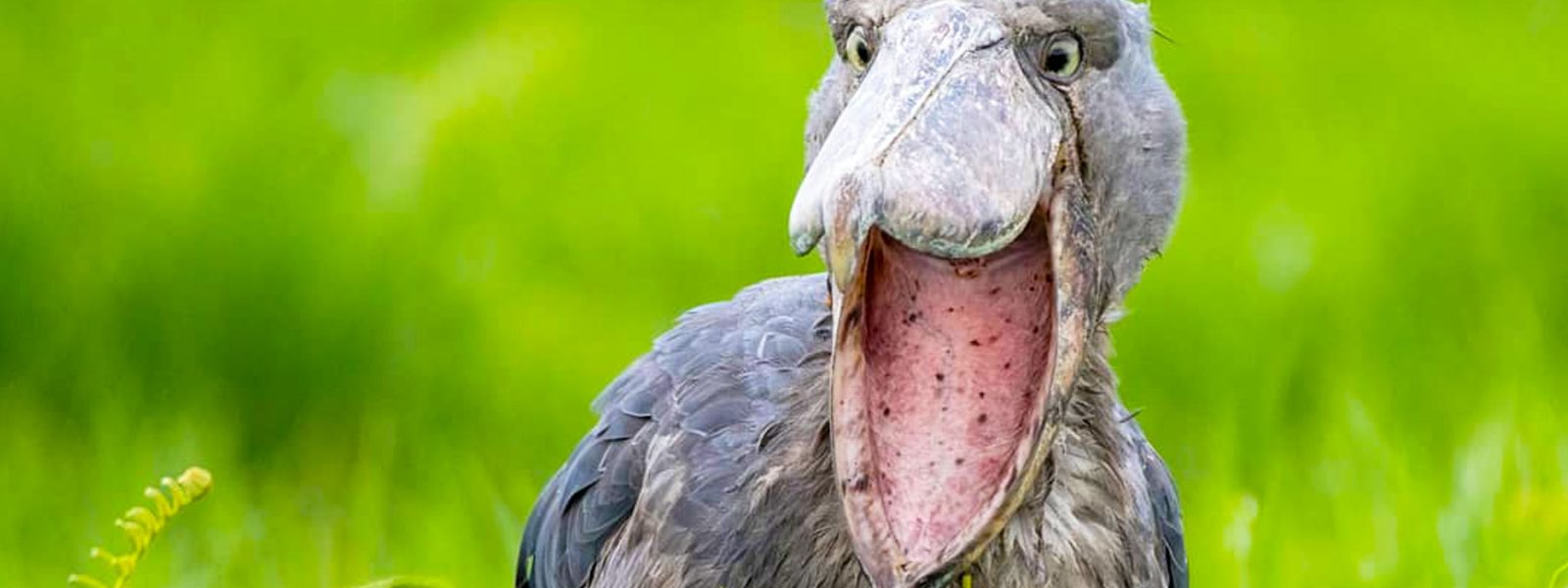Introduction
One of the most iconic and mysterious birds of Africa, the shoebill stork (Balaeniceps rex) is a dream sighting for birders and wildlife enthusiasts around the world. With its towering frame, piercing stare, and prehistoric appearance, the shoebill seems to step right out of a Jurassic-era painting. But unlike the dinosaurs it resembles, this fascinating species is still alive — though increasingly rare.
In Uganda, Murchison Falls National Park and the surrounding Nile Delta wetlands offer one of the best chances to encounter this elusive bird in the wild. This article explores the shoebill stork’s behavior, habitat, conservation status, and best practices for spotting it during your safari.
What is the Shoebill Stork?
The shoebill, also known as the whale-headed stork, is a large bird found in the swamps and wetlands of East and Central Africa. It is not a true stork but is more closely related to pelicans and herons.
Key Characteristics:
- Height: Up to 150 cm (5 feet)
- Wingspan: Over 2.4 meters (8 feet)
- Weight: Around 4 to 7 kg
- Distinctive Bill: Massive, shoe-shaped beak with a sharp hook
- Coloration: Slate gray with darker flight feathers
Birds of Murchison Falls
Shoebill Facts – Audubon Society
Where to Find Shoebills in Uganda
Uganda is among the best places in the world to find shoebills, particularly in the Nile Delta of Murchison Falls National Park. Other key locations include:
- Mabamba Bay Wetland (near Entebbe)
- Zziwa Rhino Sanctuary
- Lake Albert Delta (accessed from Paraa area)
Top Spot in Murchison Falls: The Victoria Nile Delta
The delta zone where the Victoria Nile flows into Lake Albert is prime habitat for the shoebill. The best way to explore this area is by taking a morning boat safari from the Paraa region.
Why the Nile Delta?
- Dense papyrus swamps
- Abundance of lungfish (shoebill’s primary prey)
- Remote, quiet waters
Boat Safaris on the Nile
Uganda Birding Hotspots
Shoebill Behavior and Diet
Shoebills are ambush predators that exhibit incredible stillness while hunting. They primarily feed on lungfish, but also eat:
- Eels
- Baby crocodiles
- Catfish
- Frogs
- Snakes
Feeding Technique
They remain perfectly still in shallow water for long periods, waiting for prey. Once a target is within reach, they lunge with their massive beak and swallow it whole.
Bird Behavior in Murchison Falls
Best Time to See the Shoebill
Shoebill sightings in the Nile Delta are possible year-round, but the best time is during the dry seasons:
- December to February
- June to August
Tips for Optimal Viewing:
- Book early morning boat safaris (6–8 AM)
- Avoid loud noises during the ride
- Bring binoculars and a long-lens camera
- Travel with a birding specialist guide
Why the Shoebill is Endangered
According to the IUCN Red List, the shoebill is classified as Vulnerable, with an estimated global population of 5,000–8,000 individuals.
Main Threats:
- Habitat destruction (wetland drainage for agriculture)
- Poaching for illegal pet trade
- Disturbance by tourism and fishermen
- Climate change affecting water levels
Conservation organizations and community-based ecotourism initiatives are working to protect their remaining habitats.
IUCN Red List – Shoebill Stork
Conservation Projects in Uganda
How Uganda is Protecting the Shoebill
Uganda has become a leader in shoebill conservation, combining government and local efforts to preserve wetlands and control tourism activities.
Key Actions Include:
- Protection of Mabamba and Nile Delta habitats
- Controlled boat access in birding zones
- Eco-tourism revenue sharing with local communities
- Research and monitoring of shoebill breeding and movement
Nature Uganda
Responsible Wildlife Tourism in Uganda
Photography Tips for Capturing the Shoebill
- Use a 300mm+ lens for detailed distance shots
- Turn off the shutter sound to avoid startling the bird
- Shoot in soft morning light for clean feather detail
- Keep your boat movements slow and steady
- Avoid flash or loud noises
Murchison Falls vs Mabamba for Shoebills
While Mabamba Wetlands (near Entebbe) are a popular spot for shoebill sightings due to proximity to the airport, Murchison Falls offers a more immersive experience, combining:
- Larger habitat range
- Wildlife-rich environment (elephants, lions, hippos)
- Fewer tourists and less noise disturbance
Planning Your Shoebill Safari in Murchison Falls
Sample Itinerary (2 Days):
- Day 1: Transfer from Kampala to Murchison Falls, overnight in Paraa
- Day 2: Early morning boat safari to Nile Delta for shoebill sightings, optional game drive after lunch, return to Kampala or continue with a longer safari
Recommended Lodges Nearby:
- Paraa Safari Lodge
- Pakuba Safari Lodge
- Nile Safari Lodge
Shoebill Safari Packages
Murchison Falls National Park Lodges
Conclusion
Encountering a shoebill stork in the wild is a rare and unforgettable experience. With its bizarre yet majestic presence, the shoebill captures the imagination of every wildlife lover who ventures into Uganda’s wetlands. And there is no better place to look than the Nile Delta in Murchison Falls National Park, where the still waters and papyrus reeds conceal one of Africa’s most extraordinary avian wonders.
Don’t miss your chance to meet the “dinosaur bird” of Uganda. Book your shoebill safari now and experience the wetlands like never before.

